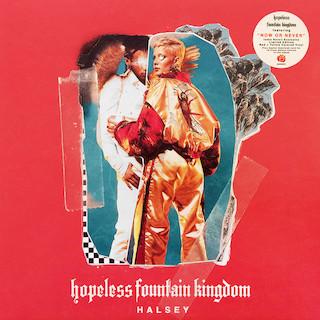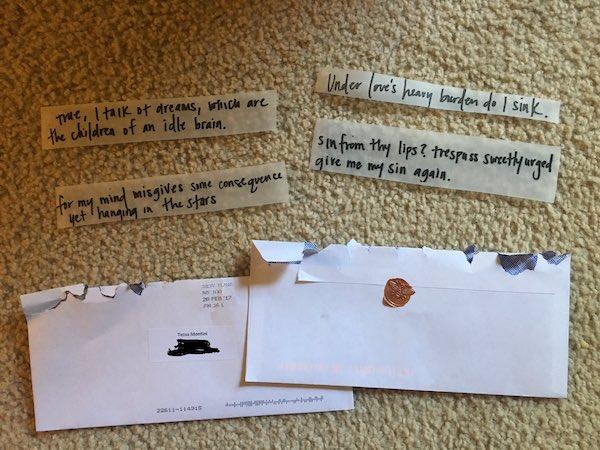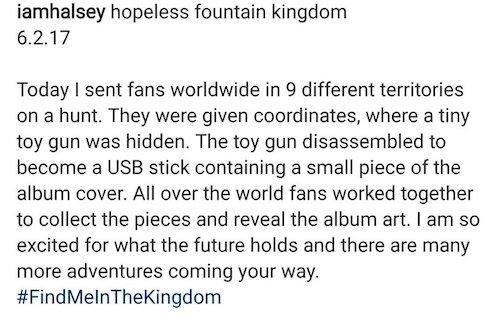
Promotion and storytelling in Hopeless Fountain Kingdom by Halsey
With the emergence of social media and the increase of mainstream technological media forms in the last decade, we have entered an age of interactivity that provides possibilities for both artists and audiences such as singer Halsey with her album Hopeless Fountain Kingdom. The potential of these new possibilities is being explored within different artistic disciplines, of which one is music. By taking advantage of our contemporary media, the musician can ‘go beyond the musical text’ and ‘take into account other surrounding media that contribute to the world-building process’ (Merlini, 2020, p. 5). In doing this, the narrative of the music becomes transmedial.
Within this context, I will explore how transmedial techniques are being used by artists to simultaneously promote music and expand creative narratives. More specifically, this paper aims at showing how transmedia storytelling inherently is both an artistic and a promotional tool simultaneously, thus making the specification of the Hollywood model redundant. To illustrate this, I will use Halsey’s Hopeless Fountain Kingdom (2017), a multimodal concept album. By analyzing the different media used in the album, I will show how the media extensions of Hopeless Fountain Kingdom simultaneously broaden the fictional narrative and promote the record.
Transmedia and Halsey
Transmedia, according to Jenkins (2016), describes ‘some kind of structured relationship between different media platforms and practices’. To distinguish transmedia from related concepts, like multimedia and cross-platform, Jenkins (2016) provides the following criteria: "Transmedia approaches are multimodal (in that they deploy the affordances of more than one medium), intertextual (in that each of these platforms offers unique content that contributes to our experience of the whole) and dispersed (in that the viewer constructs an understanding of the core ideas through encounters across multiple platforms)."
Since transmedial techniques are being used by all kinds of producers, Jenkins distinguishes between transmedia logics: "different kinds of goals that transmedia producers pursue" (Jenkins, 2016). Moreover, he argues that "we are seeing different logics get mixed and matched" with as an example the Hollywood model, which involves the "blurring of lines between storytelling and promotion/branding, with extensions building audience engagement around the so-called “mothership”’ (Jenkins, 2016). To elaborate further on what characterizes transmedia, Jenkins (2009a, 2009b), provides seven core principles that can be categorized into two main characteristics.
The first characteristic of a transmedia narrative is that it encourages active audience participation and seeks ‘fanlike engagement’ (Davis, 2013, p. 185). This is done by providing the viewer with content to either spread or dig into, the spreadability vs. drillability principle; by immersing the viewer in a story world or enabling them to take part of the narrative into their own lives, the immersion vs. extractability principle; and by giving the audience a site of potential performance in which they can make their own contributions, the performance principle.
The second characteristic is that transmedia storytelling provides the transmedial producer with a way to explore the narrative. This can be done by giving shape to a story in either a continuous structure in different media or by exploring alternate realities, described as the continuity vs. multiplicity principle. Furthermore, the seriality principle, meaning that chunks of stories are spread throughout media forms, provides the producer with countless options to explore the narrative. Related to this is the subjectivity principle, which emphasizes how transmedia extensions enable the producer to give shape to multiple perspectives within the story world. These three principles fall under one overarching principle, that emphasizes the explorative narratological qualities of transmedia storytelling: worldbuilding.
These core principles show us how both the ability to artistically explore the narrative of the story world and audience participation, thus promoting the artwork and its story world, are inherent qualities of transmedia storytelling. To see these qualities at work, I will use Halsey’s Hopeless Fountain Kingdom as a case study.
Halsey’s Hopeless Fountain Kingdom
Hopeless Fountain Kingdom (HFK), American singer-songwriter Halsey’s sophomore album, was released on June 2, 2017. The concept album is a modernized version of Shakespeare’s Romeo and Juliet and follows the star-crossed lovers Luna and Solis.

Figure 1: The album cover of Hopeless Fountain Kingdom
Since "artists from a variety of genres rely heavily upon current technologies and social media platforms to develop elaborate promotional strategies, thus expanding the idea of the concept album to the concert tour, music videos, books, and a range of supplementary materials" (Burns, 2016, p. 91), it is no surprise that HFK’s story is explored throughout different media platforms. Besides the record itself, which features thirteen tracks, the narrative can be experienced through music videos[1], Twitter accounts, letters[2], a treasure hunt[3], and a newspaper[4].
For this paper, I will distinguish between the transmedial ‘mothership’ and its extensions (Jenkins, 2016). The mothership of HFK is the record itself. The extensions are the other media listed above. To see how these extensions of HFK enhance both the album’s fictional narrative and audience participation, an in-depth analysis will follow.
Building a story world and activating the audience: the media extensions of HFK
When Halsey ended her first stadium tour with an on-screen text that read ‘YOU CAN FIND ME IN THE KINGDOM…’, suspense among her fans was immediately built. In the months leading up to the release of HFK, Halsey found several opportunities to establish the narrative of her upcoming record, as well as promote the future release of her music.
On February 16, 2017, the Twitter account @houseofangelus was created. On March 7, three other accounts followed: @lunaaureum, @houseofaureum, and @solisangelus. The two characters that are central to HFK are explored in-depth through these accounts. This relates to the subjectivity principle of transmedia, as Halsey is giving shape to different perspectives of characters through this transmedial extension. Halsey is "reworking these narratives to engage fan communities in social media and to establish a closer communication with them" (Viñuela, 2020, p. 219). Moreover, Halsey makes use of the immersion principle of transmedia by giving her fans a chance to follow the characters and immerse themselves in the world. Furthermore, Halsey enables her fans to easily share the content through Twitter, calling upon the spreadability of transmedia extensions.
Another way in which Halsey uses a different media extension as a way to explore the artistic narrative and activate her audience is with letters to fans containing Romeo and Juliet quotes. This media extension calls upon the spreadability of transmedia as well, as fans were encouraged to share these messages with other fans online, calling attention to Halsey’s upcoming record. Furthermore, by choosing a personalized form of communication, Halsey makes use of the extractability principle of transmedia, incorporating the fictional narrative into the day-to-day lives of her fans. Also, by sending Romeo and Juliet quotes, Halsey establishes the theme of the narrative, emphasizing an intertextual relationship with the Shakespeare text. This is important, since "the extramusical content of the concept album is vital to the production of meaning" (Burns, 2016, p. 95). To fully understand the story that takes place within the HFK-universe, the relationship with the original work by Shakespeare has to be established. Halsey makes use of the letters as a worldbuilding device.

Figure 2: The handwritten letters sent by Halsey to her fans, as shared by fans on Twitter
Closely related to the handwritten letters is the fictional newspaper The Kingdom Times that was sent to a select group of fans. Similar to the letters, this media extension calls upon the spreadability and extractability principles of transmedia, thus acting as a promotional device. Furthermore, since the newspaper contains articles that provide background information on events in the story world, the narrative is explored through several transmedial principles, among which is the continuity principle, since the fictional events reported refer to the fictional contents of the other media extensions.
Furthermore, a worldwide scavenger hunt was hosted on March 31st. In nine cities across the world, Halsey hid small gun-shaped USB sticks containing information about the album (see Figure 3). The scavenger hunt offered the fans a site of active participation, relating to the performance principle of transmedia. Both the locations where the USB drives were found, such as the Romeo and Juliet statue in New York, and the USB itself, shaped like a gun as a reference to the 1996 Baz Luhrmann adaptation of Romeo and Juliet, acted as a means to broaden the story world of HFK since it emphasized the theme and narrative further by establishing intertextual relationships to both the Shakespeare play and the 1996 adaptation of the story[5].

Figure 3: The caption of a now-deleted Instagram post by Halsey about the USB stick hunt
The last media extension that was used to explore the narrative of HFK and promote both the album and the tour that followed, is that of the music video. Within her videos, Halsey explores the story world of HFK by following the subjectivity principle, as different parts of the story are explored visually, giving context to the messages of the songs. Furthermore, by releasing two videos for one song, as she does with Bad At Love and Bad At Love (Angelus Cut), alternate realities are explored, following the multiplicity principle. The viewer is provided with scenery, settings, clothes, and characters, further elaborating on the universe in which the record takes place, thus making this media extension a site of creative, artistic exploration and world-building.
In the videos, Halsey makes use of easter eggs as well. These small, hidden messages are smart ways of motivating the audience, since they encourage the viewer to dive into the story world to look for information, relating to the drillability principle of transmedia. In the case of HFK, one of these easter eggs was a phone number hidden in the music video for Now Or Never. When dialing the number, fans were presented with an instrumental version of a song that was not yet released, again building suspense for the release of Halsey’s album. Furthermore, when the phone number was called on specific dates leading up to Halsey’s HFK Tour, callers received a code to access the tour’s pre-sale. Lastly, fans received text messages from the number that read ‘You have been chosen. Make peace’. This message, which is a recurring text in multiple media extensions, acts as a way to immerse the viewer into the story world.
By giving shape to the HFK album through these transmedial extensions, Halsey makes use of the inherent qualities of transmedial principles to both promote her record, and create a layered, explorative narrative.
Transmedia in Halsey's work
With Jenkins’s definitions of transmedia (2009a, 2009b, 2016), we see that transmedia simultaneously provides the producer with a means to explore a story world, and to create active audience engagement, thus making it a means of promotion. As shown by exploring Halsey’s Hopeless Fountain Kingdom, transmedia extensions are used as a way to simultaneously explore the story world and promote the artistic product. This proves Jenkins’ suggestion that different transmedial logics are being mixed, such as in the Hollywood model.
A transmedia extension is never solely promotional, since "each extension adds something we did not know before and thus deepens our emotional connection to the material" (Jenkins, 2016). A transmedia extension is also never solely artistic, since ‘part of what drives transmedia consumption is the desire to dig deeper into these worlds,' (Jenkins, 2016) and transmedia extensions ‘elicit fanlike behaviours entailing psychological investment and social involvement in ‘‘spreading’’, distributing, commenting on and creating media content’ (Davis, 2013, p. 185).
The essence of transmedia storytelling is that it is simultaneously an artistic tool and a way to engage the audience with a product, thus making it a promotional tool. This means that the Hollywood model as a specific term is redundant: the blurring of storytelling and promotion is inherent to transmedia narratives and story worlds because it lies at the core of transmedia storytelling.
Endnotes
[1] The seven videos are accessible through Halsey’s official Youtube Channel, and are, in order of release date: Now Or Never, hopeless fountain kingdom (Album Trailer), Bad At Love, Bad At Love (Angelus Cut), Sorry, Alone and Strangers
[2] Since the letters were sent to a select group of fans, they were not accessible to a wide public. Pictures of the letters were shared by fans on Twitter, however, for example by user @rebeccamccainn in this tweet on March 5, 2017
[3] Because the treasure hunt was a real-life, real-time event, it has not been fully archived online. The tweet that instigated the treasure hunt is still online, however, as are tweets and blog posts about fans documenting the experience, as an example in this tweet from user @kierraaawright on March 31, 2017, and in this post by Deepa Lakshmin on MTV.com
[4] Similar to the letters containing the Romeo and Juliet quotes, the newspaper was sent to a select group of fans, and thus was not accessible to a wide public. A picture of the Kingdom Times was shared by Halsey on her Twitter account in this tweet on April 28, 2017, however
[5] The connection to the Baz Luhrmann adaptation of Romeo and Juliet, Romeo + Juliet (1996), was quickly made by Halsey’s fans on Twitter, as seen in this tweet by @EmmaDeArcaute on March 31, 2017. References to the Luhrmann adaptation are present in the music video of Now Or Never as well.
References
Burns, L. (2016). The Concept Album as Visual—Sonic—Textual Spectacle: The Transmedial Storyworld of Coldplay’s Mylo Xyloto. IASPM@Journal, 6(2), 91–116.
Davis, Charles. H. (2013). Audience Value and Transmedia Products. In T. Storsul & A. H. Krumsvik (Eds.), Media Innovations (pp. 175–190). Nordicom.
Jenkins, H. (2009a, December 12). Revenge of the Origami Unicorn: The Remaining Four Principles of Transmedia Storytelling. Henry Jenkins.
Jenkins, H. (2009b, December 12). The Revenge of the Origami Unicorn: Seven Principles of Transmedia Storytelling (Well, Two Actually. Five More on Friday). Henry Jenkins.
Jenkins, H. (2016, November 15). Transmedia What? by Henry Jenkins. Medium.
Merlini, M. (2020, June). Lost in the Stream. Concept Album in the Age of Streaming. IASPM Norden Conference 2020, Luleå University of Technology, Online.
Viñuela, E. (2020). Metanarratives and Storytelling in Contemporary Mainstream Popular Music: Romeo and Juliet in the Making of the Star Persona. Text Matters, (10), 209–222.